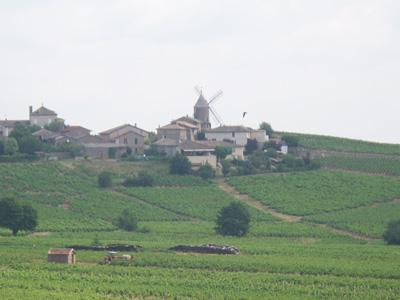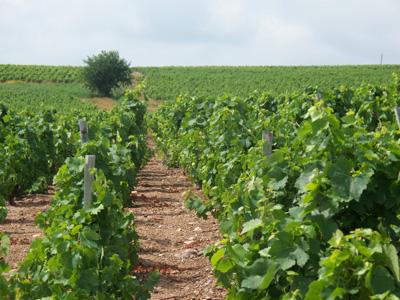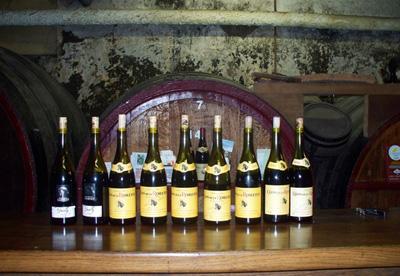Alain Coudert and his Clos de la Roilette have provided me with two important experiences: one was the best bottle of Beaujolais that I’ve ever drunk - the 1999 Vendange Tardive; the other was my first andouillette, which I actually managed to enjoy over lunch with Coudert and a bottle of 07 Metras Fleurie VV. Crazily enough, I feel like I owe Coudert enormously for both.
More on the 99 Tardive in a moment, but first we need to pause on the andouillette, a tripe sausage that has always elicited fear and revulsion in my mind. When it comes to tacos de tripas, I’m down. But I head the other way when it comes to anything else remotely involving tripe. I believe I had consciously decided never to eat an andouillette.
 |
Yet, when I asked Coudert what he was ordering at lunch and he said, “It might be difficult for you…” I ordered one on the spot. In part, I’m sure it was some sort of social pressure. Who wants to look small in front of a Beaujolais winemaker? Who wouldn't want to down a regionally appropriate andouillette while sitting outside in the center of Fleurie? There was more to it, though. It was my first full day in Beaujolais; I had woken up, walked out to the car and looked directly at one of Fleurie’s best and most impressive climats, Grille Midi. I drove to Coudert's looking up at La Madone. Alain Coudert is one of the nicer people of the world, and the tasting was great in every way.
If tripe sausages could ever taste good, right then and there was most likely the time...
I liked it well enough.
Then there was another andouillette that appeared when I was out to dinner with Foillard, Metras, and a bunch of other winemakers. Finally, when I returned to Paris, there was an andouillette tirée à la ficelle, a hand-stuffed version. I felt like I had to try an artisanal version, since I was told that my prior two were “industrial” ones. Having two already under my belt, I knew what to expect and actually very much enjoyed the richly earthy depths and superior texture of the hand-stuffed version. All in all, three andouillettes in six days. Thanks, Alain, I might be hooked now, especially when the andouillette’s richness is offset with Beaujolais’ tart fruit and lip-smaking acidity.
Okay. Enough andouillette talk; back to Coudert and his wines. They just might be the most complex and ageworthy wines the region has to offer. The 99 Tardive that I mentioned above has assumed a nearly mythical status among the people I drank it with two years ago. I had attended an 04 Grand Cru Chablis Executive Seminar immediately prior, and the night’s lineup had some serious bottles: 82 Giacosa Santo Stefano Red Label, 89 Robert Denis Azay-le-Rideau sec, 05 Willi Schaefer Domprobst Spatlese #8. But compared to the Tardive, everything else was entirely forgettable.
The history of the domaine is so famous that it hardly needs to be told again. Here it is, briefly: Up until the 1920s when Fleurie was created, Roilette (both the name of the estate and a climat) was part of Moulin-à-Vent. Losing the Moulin-à-Vent appellation upset Roilette’s previous owner, and he decided going forward to make no mention of the Fleurie appellation, instead putting only a big picture of his race horse on the label.
La Roilette (the climat) shares Moulin-à-Vent’s manganese soils with a large portion of clay. The vineyard faces east. If you look at the picture below, taken from in front of Coudert’s winery, Fleurie ends and Moulin-à-Vent begins right around the trees.
 |
You definitely pick up more of the structured depth of Moulin-à-Vent in Roilette’s wines than the finessed delicacy found in the central part of Fleurie.
Photo right: La Roillette (Fleurie) ends and Moulin-a-Vent begins at tree line.
The domaine consists of 13ha total, 12 in Fleurie and one in Brouilly. The one hectare in Brouilly belonged to Alain Coudert’s grandfather, and up until 2005 was worked by his uncle. The Brouilly achieves more ripeness than their Fleurie. In 09, the strawberry-scented Brouilly weighs in at over 14% alcohol, while the basic Fleurie is at 13.3%, and the Vendange Tardive is 13.8%. In Fleurie, the majority of their holdings are in Roilette and a nearby area with similar soils. In addition, they own a few hectares closer to the heart of Fleurie in the climats of Champagne and Deduits. Tardive parcels in Roilette are always the last to be harvested. When the Couderts purchased Clos de la Roilette in the late 1960s, the estate had been neglected for years and much replanting was required. The average vine age is around 25 to 30 years old.
I like to think of Roilette as one of the great traditional Beaujolais. Though, of course, “traditional” is a moving target meaning wildly different things to different people. At Roilette, grapes undergo semi-carbonic fermentation in large open-top wooden barrels. The wines then age in large barrels for a brief period of time.
In difficult vintages, a touch of sulfur may be used before fermentation, such as in 08 - a vintage that Coudert described as the most difficult he’s experienced. 2009, with its pristine quality of fruit, saw no sulfur before fermentation. The amount of stems included during maceration varies depending on the vintage as well, with 20% in 2008 and much more in 09. (I didn’t get an exact number from Coudert for 09, but it’s safe to assume we’re looking at a high percentage.) There are two issues with stems: If they’re not ripe enough they impart astringency to the wines; also, when there is a large amount of hail the stems can give the wines something of an earthy, dirty potato flavor.
I find the style of Roilette’s wines to be totally fascinating. It’s difficult to put your finger on; you naturally want to draw comparisons with the Côte d’Or, but as often it’s the Rhône that pops up. That 99 Tardive was decidedly Rhône-like in its meaty, spicy and smoke-inflected profile.
Beaujolais, as a region in general, is hard to classify. The food is rich and marked by the use of butter, and yet there is a sun-soaked, carefree attitude that one associates with France’s south. This area marks the northern limits of where olives can ripen. Nearly every house has an olive tree, and fig trees are everywhere. Beyond the wines, it’s a wonderful place to spend time.
Roilette’s Fleuries are marked by dark fruits ranging from plums to mulberries to dark cherries, meaty elements, smoke, olives, pepper, licorice and menthol. There’s also a fascinating salty, nutty-savory component married to forest floor in the wines. Of course, there’s also a lovely and complex floral nature to them... violets, for sure, but also the likes of irises and other lovely petals that, after living in big cities for nearly a decade, I just can’t put my finger on. Let’s just leave it at bright, complex florality. I can’t think of another Beaujolais that offers such a range of flavors and scents.
 |
The jewel in the crown at Roilette is the Cuvée Tardive, their famous spoof on Beaujolais nouveau. Call it the anti-Beaujolais nouveau. It’s a wine that, while not being impenetrable when young, certainly benefits from cellaring. The Tardive comes from two parcels of vines that are 80+ years old; the largest parcel is behind Coudert’s home. The first vintage of Tardive was 1995. It tends to see a bit longer maceration and higher fermentation temperature, all of which contribute more structure and richness to the wine. Production can vary greatly vintage to vintage. Case in point: There were 7,000 bottles produced in 09 and only 1,000 produced in 08.
Tardive tends to get all the attention, but during my tastings I developed a newfound respect for the basic Fleurie cuvée, which is assembled from Roilette’s various vineyards, both bordering Moulin-à-Vent and located more in the center of Fleurie. The 09 is particularly good. An 02 drunk at Auberge du Cep on the same day as my Roilette visit was also good. Compared to Tardive, the basic Fleurie has less ripeness, structure and meatiness. But it makes up for that with a crackling acidity and perfume while possessing all of Roilette’s stylistic signatures.
Alain Coudert, like nearly every other winemaker in the region, is particularly fond of the 09s. He compares his to those from 1991, a vintage that serves as a benchmark for him. For a wine that is never short on profundity, the 09 Tardive is simply monumental. However, for the first time ever, I’ll be buying equal quantities of the basic Fleurie as well. It’s pretty outrageous in 09. It will also help me keep my hands off my Tardive, which will have a very long life ahead of it.
 |
2008 Brouilly
Pretty strawberry perfume with red cherries, dark spices. Plenty of lift.
2009 Brouilly
Darker, richer, bigger than 08. Plenty of structure. Nice strawberry perfume with smoke and darker fruits underneath. If this had been served a bit warmer, the alcohol may have peeked out.
2007 Fleurie
Bright with plenty of perfumed, spicy vigor. Quite good.
2008 Fleurie
Marked by pepper, dark and tart fruits; has Roilette’ typical savory quality a bit more in the fore.
2009 Fleurie
Lots more muscle here. Violets, olives and spices soar from the glass. Lots of potential.
2009 Tardive
There’s a lot of richness and ripeness here, but it’s all in balance. The depth and length here is monumental.
2008 Tardive
Plenty of 08 spiciness. Not the most concentrated wine out there, but lots of pleasing, crackling freshness. I’d happily drink more than one glass.
2007 Tardive
Really good. I wish I bought more. Lots of snap and concentration. Blackberry fruit combined with bright acidity, flowers, burning leaves and an elusive meatiness.
2000 Tardive
Coudert considers this a good vintage for the wine. Mature, but by no means over the hill. More Burgundy than Rhône in its black cherry fruits that take the lead. Maybe a touch simpler than top vintages of Tardive.
